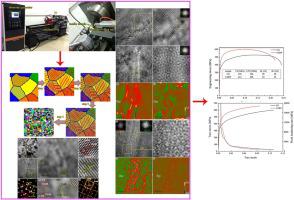Journal of Materials Processing Technology ( IF 6.7 ) Pub Date : 2021-08-12 , DOI: 10.1016/j.jmatprotec.2021.117322 Lei Lei 1, 2 , Qinyang Zhao 3 , Yongqing Zhao 1, 2 , Cong Wu 2 , Shixing Huang 2 , Weiju Jia 2 , Weidong Zeng 1

|
In this study, ultrasonic surface rolling process (USRP) was used to fabricate a gradient nanostructured commercial pure titanium. The site-specific microstructure, refining mechanisms and mechanical properties were investigated by high-resolution transmission electron microscopy, electron backscatter diffraction and tensile test. The results show that the surface layer exhibited multi-gradient features along the depth, including grain size gradient, deformation twin gradient, strain gradient, orientation gradient and hardness gradient. The gradient structure consisting of equiaxed nanograin layer, elongated lamellar layer, deformation twinning profuse layer, and coarse-grained layer along the depth direction. The formation mechanisms of gradient nanostructure are thoroughly elucidated, and the synergistic effect of twin and dislocation plays an important role in grain refinement. In addition, amorphous bands (generated by localized dislocations or phase transformation triggered crystalline to amorphous transition) and nano-thick lamellar with face-centered cubic (FCC) structure (<0001>HCP//<001>FCC, {1 00}HCP//{2 0}FCC and {11 0}HCP//{220}FCC) were formed in the nanograin layer, and the phase transformation mechanisms were elucidated. The HCP to FCC phase transformation and amorphization play a role in refining grain. Tensile test results suggested that the gradient nanostructure improved the strength (yield strength and ultimate tensile strength improved from 342 MPa and 526 MPa to 412 MPa and 598 MPa, respectively) while maintaining enough plasticity. The strength-plasticity synergy was attributed to the coordinated deformation of the gradient nanostructure and the coarse-grained core.
中文翻译:

超声表面轧制纯钛的梯度纳米结构、相变、非晶化和增强的强度-塑性协同作用
在这项研究中,超声表面轧制工艺 (USRP) 用于制造梯度纳米结构的商用纯钛。通过高分辨率透射电子显微镜、电子背散射衍射和拉伸试验研究了特定位点的微观结构、细化机制和力学性能。结果表明,表层沿深度呈现多梯度特征,包括晶粒尺寸梯度、变形孪晶梯度、应变梯度、取向梯度和硬度梯度。沿深度方向由等轴纳米晶粒层、拉长层状层、形变孪晶层和粗晶层组成的梯度结构。彻底阐明了梯度纳米结构的形成机制,孪晶和位错的协同作用对晶粒细化起重要作用。此外,非晶带(由局部位错或相变产生,触发晶体到非晶转变)和具有面心立方 (FCC) 结构的纳米厚层状结构 (<0001>HCP //<001> FCC , {100} HCP //{20} FCC和 {110} HCP //{220} FCC ) 在纳米晶粒层中形成,并阐明了相变机制。HCP 到 FCC 的相变和非晶化在细化晶粒中起作用。拉伸测试结果表明,梯度纳米结构提高了强度(屈服强度和极限拉伸强度分别从 342 MPa 和 526 MPa 提高到 412 MPa 和 598 MPa),同时保持足够的塑性。强度-塑性协同作用归因于梯度纳米结构和粗晶核的协调变形。











































 京公网安备 11010802027423号
京公网安备 11010802027423号